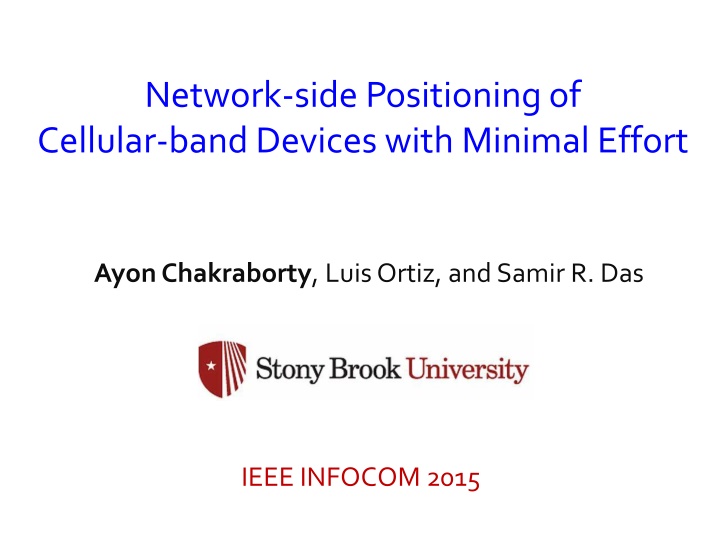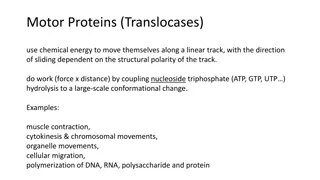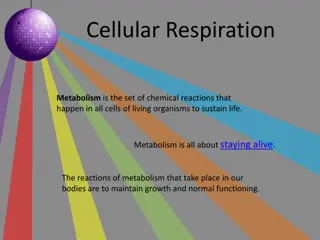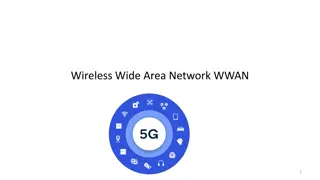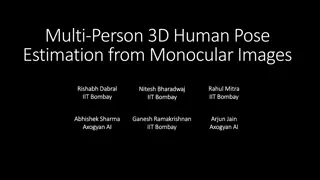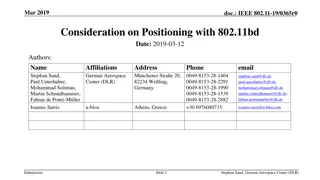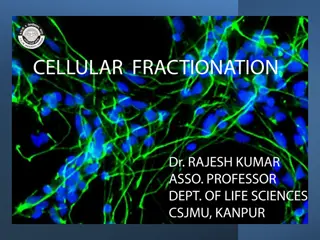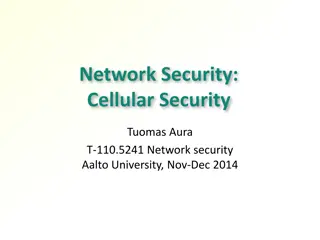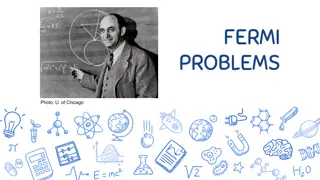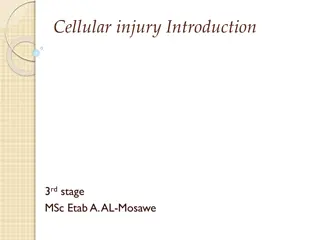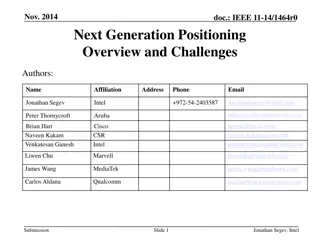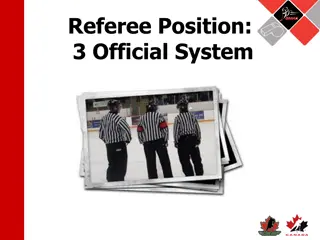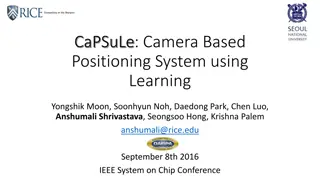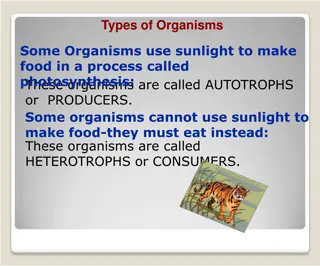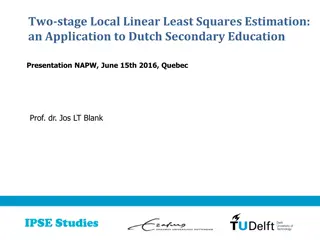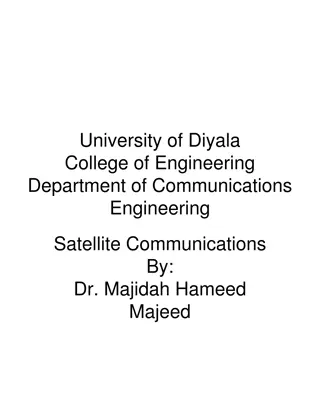Cellular Network Positioning Techniques for Location Estimation
Utilizing cellular signal strength information for positioning devices within a network, this study explores network-side positioning methods such as fingerprinting in cellular networks. The research delves into the process of estimating device locations by analyzing received signal strengths from neighboring cell towers, highlighting the constraints faced by network providers compared to over-the-top apps in accessing sensor data for location tracking.
Download Presentation

Please find below an Image/Link to download the presentation.
The content on the website is provided AS IS for your information and personal use only. It may not be sold, licensed, or shared on other websites without obtaining consent from the author.If you encounter any issues during the download, it is possible that the publisher has removed the file from their server.
You are allowed to download the files provided on this website for personal or commercial use, subject to the condition that they are used lawfully. All files are the property of their respective owners.
The content on the website is provided AS IS for your information and personal use only. It may not be sold, licensed, or shared on other websites without obtaining consent from the author.
E N D
Presentation Transcript
Network-side Positioning of Cellular-band Devices with Minimal Effort Ayon Chakraborty, Luis Ortiz, and Samir R. Das IEEE INFOCOM 2015
What is Network-Side Positioning? Neighboring Cell Towers Cell phone located at <X, Y> Serving Cell Tower RSS2 RSS1 RSS1 RSS2 RSS3 RSS3 Estimate Location X , Y RSS: Received Signal Strength 2 WINGS Lab
Network Providers are Constrained Unlike OTT Apps typically no direct access to such sensors ONLY utilize cellular signal strength information Sensors Galore! 3 3 WINGS Lab
Fingerprinting in Cellular Networks Fingerprint Database Location Feature Vector X1, Y1 < RSSA RSSB RSSC>1 RSSB RSSA Tower A (X1, Y1) Tower B RSSC Tower C 4 4 WINGS Lab WINGS Lab
Fingerprinting in Cellular Networks Fingerprint Database Location Feature Vector X1, Y1 < RSSA RSSB RSSC>1 X2, Y2 < RSSA RSSB RSSC>2 Tower A Tower B RSSB RSSA (X2, Y2) RSSC Tower C 5 5 WINGS Lab WINGS Lab
Fingerprinting in Cellular Networks Fingerprint Database RSSA RSSB Location Feature Vector (X3, Y3) X1, Y1 < RSSA RSSB RSSC>1 RSSC X2, Y2 < RSSA RSSB RSSC>2 Tower A X3, Y3 < RSSA RSSB RSSC>3 Tower B Tower C 6 6 WINGS Lab WINGS Lab
Fingerprinting in Cellular Networks Fingerprint Database Location Feature Vector X1, Y1 < RSSA RSSB RSSC>1 X2, Y2 < RSSA RSSB RSSC>2 Tower A X3, Y3 < RSSA RSSB RSSC>3 Tower B X4, Y4 < RSSA RSSB RSSC>4 X5, Y5 < RSSA RSSB RSSC>5 XN, YN < RSSA RSSB RSSC>N Tower C 7 7 WINGS Lab WINGS Lab
Fingerprinting in Cellular Networks Fingerprint Database Location Feature Vector X1, Y1 < RSSA RSSB RSSC>1 X2, Y2 < RSSA RSSB RSSC>2 Tower A X3, Y3 < RSSA RSSB RSSC>3 Tower B X4, Y4 < RSSA RSSB RSSC>4 X5, Y5 < RSSA RSSB RSSC>5 XN, YN < RSSA RSSB RSSC>N Tower C 8 8 WINGS Lab WINGS Lab
Fingerprinting-based Localization Techniques Fingerprint Database Test Data ?, ? < RSSA RSSB RSSC > Location Feature Vector X1, Y1 < RSSA RSSB RSSC>1 X2, Y2 < RSSA RSSB RSSC>2 Estimate Location X3, Y3 < RSSA RSSB RSSC>3 X4, Y4 < RSSA RSSB RSSC>4 X5, Y5 < RSSA RSSB RSSC>5 X , Y Many deterministic / statistical techniques Median accuracy 100 200m XN, YN < RSSA RSSB RSSC>N 9 9 WINGS Lab WINGS Lab
Accuracy Depends on Fingerprint Density Fingerprint Database Test Data ?, ? < RSSA RSSB RSSC > Location Feature Vector X1, Y1 < RSSA RSSB RSSC>1 X2, Y2 < RSSA RSSB RSSC>2 Estimate Location X3, Y3 < RSSA RSSB RSSC>3 X4, Y4 < RSSA RSSB RSSC>4 X5, Y5 < RSSA RSSB RSSC>5 X , Y XN, YN < RSSA RSSB RSSC>N (# of Locations) Cost 10 10 WINGS Lab WINGS Lab
Our Work: Minimizing Labeled Data Requirement Fingerprint Database Test Data ?, ? < RSSA RSSB RSSC > Location Feature Vector X1, Y1 < RSSA RSSB RSSC>1 < RSSA RSSB RSSC>2 Estimate Location ____ , ____ X3, Y3 < RSSA RSSB RSSC>3 < RSSA RSSB RSSC>4 ____ , ____ < RSSA RSSB RSSC>5 ____ , ____ X , Y Minimize labeled data Provide good accuracy with less cost XN, YN < RSSA RSSB RSSC>N Unlabeled Data Labeled Data 11 11 WINGS Lab WINGS Lab
Mostly Unlabeled Data, Few Labeled Data Tower A Tower B Unlabeled data Labeled data + = Semi-supervised Setting Tower C 12 12 WINGS Lab WINGS Lab
Semi-supervised Clustering Tower A Tower B Unsupervised clustering Labeled data anchors clusters Tower C 13 13 WINGS Lab WINGS Lab
Location Estimation L1 P1 P5 Tower A Physical location of cluster 2 L5 Tower B L2 P2 5 = k L4 = RSSA RSSB RSSC * L L P UE K K Prob. that phone belongs to cluster 4 L3 1 P3 P4 Tower C 14 14 WINGS Lab WINGS Lab
Semi-supervised Modeling Approach Marginal Gaussian PDF of Signal S (received signal strengths from towers), given location L (hidden variable) fS|L Mixture of independent Gaussians (GMM) over all possible locations Learning problem: Learn fS|L = f | SK L K 15 15 WINGS Lab WINGS Lab
A Simple Example Combined Gaussian distribution actually seen Gaussian distribution at E Gaussian distribution at W Probability W E Signal strength Many unlabeled signal strength samples Few samples with label E or W Given test signal STest estimate the probabilities p(W| STest) and p(E| STest) 16 16 WINGS Lab WINGS Lab
A Simple Example p(W|RSS2) = 0.65 P(E|RSS2) = 0.35 p(W|RSS1) = 0.1 p(E|RSS1) = 0.9 p(W|RSS3) = 0.95 p(E|RSS3) = 0.05 Midpoint of W Probability Midpoint of E W E RSS1 RSS2 Signal strength RSS3 Estimated location = p(W|RSS)*midpoint of W + p(E|RSS)*midpoint of E. 17 17 WINGS Lab WINGS Lab
Our Experimental Setup University campus: Partitioned into uniform grid (15mx15m) Each grid cell one location 3K grid cells. 2.5 Kms (approx.) 2.5 Kms (approx.) Not drawn to scale 18 18 WINGS Lab WINGS Lab
Data Collected 35K samples at outdoor locations T-Mobile s GSM network on Nexus4/5 phone (our technique not specific to GSM though) 10K samples kept aside for testing 19 19 WINGS Lab WINGS Lab
Algorithm Overview Step 1: Initialize each location with a Gaussian(mean, variance) and prior probability for the location Step 2: Run Expectation Maximization (EM) Handles partially-labeled training data The EM converges to the local MLE Yields learned model Step 3: Predict using learned model 20 20 WINGS Lab WINGS Lab
Median Accuracy 70m Mixture Model K-Nearest Neighbors Gaussian Na ve Bayes 10% training samples have labels 21 21 WINGS Lab WINGS Lab
Median Accuracy 90m Mixture Model K-Nearest Neighbors Gaussian Na ve Bayes 1% labeled training samples 22 22 WINGS Lab WINGS Lab
Observation 1: More Unlabeled Data Reduces Error 2% 20% Of course, up to theoretical limit (Bayes Risk) Good news! Unlabeled measurements easy to obtain 23 23 WINGS Lab WINGS Lab
Observation 2: Higher Errors are Spatially Clustered 24 24 WINGS Lab WINGS Lab 24
Observation 3: Accuracy Improves with Cell Tower Density # of features = cell towers heard Almost 40m! Potential for good performance in high density deployments (e.g., small cells / urban regions) 25 25 25 WINGS Lab WINGS Lab WINGS Lab
Summary of Our Contributions Minimize labeled training data requirement a cost center for operators 1% labeled data achieves 90m median accuracy Additional unlabeled data improves accuracy, up to a theoretical limit (Bayes risk) Possible to extend to completely unsupervised setting (see paper) 26 26 26 WINGS Lab WINGS Lab WINGS Lab
Thank You Acknowledgement Huawei Technologies, New Jersey, USA 27 27 WINGS Lab WINGS Lab
Cell Towers The region (University campus) is partitioned into a uniform grid (15mx15m) and each grid cell represents a candidate location (~3K grid cells). Remove cell towers backup 2.5 Kms (approx.) Cell Tower These are our locations. 29 2.5 Kms (approx.) WINGS Lab
